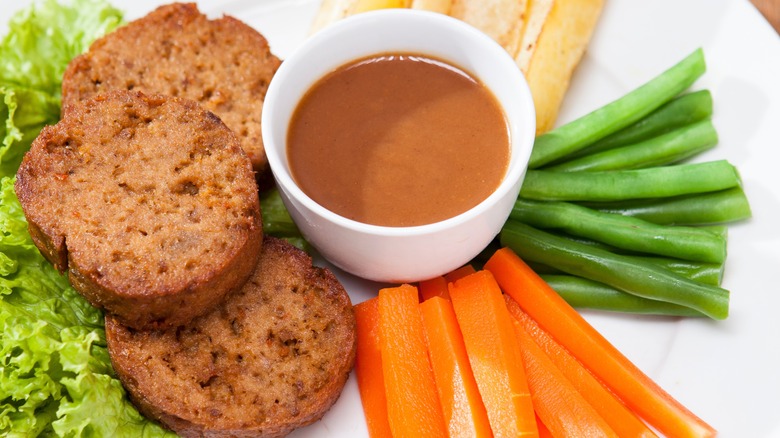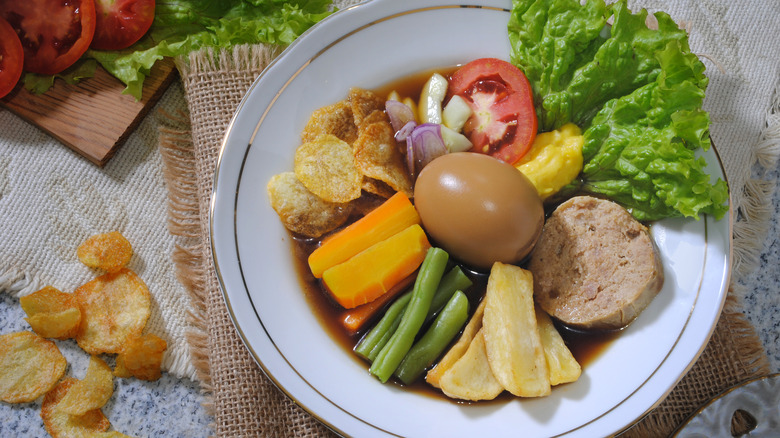Bistik Jawa Is The European-Indonesian Fusion Steak You Should Try
If your celebratory steak dinners have felt a little repetitive lately with their typical A.1. or barbecue sauce pairings, you might want to consider mixing it up with a South East Asian take on the dish. Bistik Jawa, meaning Javanese beefsteak, is a delicious dish made with thinly-sliced meat and a dousing of sweet sauce. Kecap manis, a sugary take on soy sauce, is the main flavor profile; it gets paired with Worcestershire sauce for a bit of tang, followed by salt, pepper, and spices like nutmeg and garlic for a savory grounding. And, don't worry. You won't have to miss out on your usual steak fries and veggie side dishes. Green beans and carrots are commonly served alongside bistik Jawa. French fries or roasted potatoes are also popular.
You might be thinking this dish sounds a bit too Westernized to be an authentic South East Asian meal. It's true that European colonization deeply impacted the cuisines across this region, and bistik Jawa is no exception. This fusion food is enjoyed across Indonesia, and there's a good reason it's so beloved.
History of bistik Jawa
Many countries in South East Asia were European colonies during the 19th century. Over the course of that century, Britain occupied Myanmar and Malaysia; France colonized Vietnam, Cambodia, and Laos; and Holland took over Indonesia. As a result, many fusion foods have remained popular in this region of the world. For example, the inclusion of a crusty baguette and cold cuts to the famed Vietnamese dish banh mi shows clear French influence. As for Indonesia, the bistik Jawa is the country's own take on a Western-style steak dinner.
This meal particularly took off on the island of Java, hence the name. Java is the most populous and one of the most well-known islands in the country. It's home to the capital city Jakarta and many other bustling metropolises across the long stretch of land. Javanese cuisine is known for leaning more on the sweet side, rather than being spicy. It also often includes nutmeg and shallots, both of which are featured prominently in bistik Jawa. While this dish may feel intimidating to create in your own kitchen, it's actually quite simple. Although, it does take a bit of patience.
How bistik Jawa is made
Be warned, bistik Jawa is not a quick and easy dinner to whip up if you're pressed for time. The entire process will take about 2 ½ hours thanks to the essential marinating that gives the beef its quintessential flavor. The first step is to place the beef steaks in a container along with the chosen spices, typically salt, pepper, and nutmeg. Kecap manis (the Indonesian sweet soy sauce) and Worcestershire sauce can also be added for a more layered flavor. You can then place the marinating meat in the fridge for anywhere from 30 minutes to overnight, depending on how much time you have to spare.
After the steak has sat in the fridge for a sufficient amount of time, it can be removed from the container and placed to the side. In a heated pot on the stove, the sauce is whisked together using the reserved marinade, stock, milk, flour, spices, and aromatics. This combination creates a thick and flavorful sauce perfect for coating the steak. In a separate hot pan with butter, the steak gets seared until crisp and brown. Now, everything is ready to be plated up with your favorite accompaniments.
How to enjoy a plate of bistik Jawa
Best served right away while the meat and sauce are still hot, bistik Jawa makes a great dinner for either a family or solo meal. The sweet sauce can either be poured over the meat to smother it or served in a cup on the side for more measured eaters. Tossing on some extra fried shallots from your pan as a garnish will add an extra savory boost.
Common side dishes for this meal are steamed carrots, cauliflower, and green beans. Any vegetable of choice will pair well, and they can be sautéed or steamed however you prefer. Roasted potatoes would also make a great, salty addition to the plate. However, some people prefer to highlight more Asian flavors by adding egg, a broth for the meat to sit in, or additional soy sauce. Really, this dish can be very customizable. Dress it up how you like and enjoy!



